Richmond Train Accident: Safety, Risk Management, and Policy Changes
VerifiedAdded on 2023/06/08
|10
|2287
|406
Report
AI Summary
This report examines a train accident that occurred at Richmond station in Sydney, Australia, highlighting the breach of safety measures that led to the incident. The report discusses the critical need for safety and risk management principles in railway operations. It details the events of the accident, including the injuries sustained by passengers and the damage to rail property. The investigation into the accident revealed that human error, specifically the driver's failure to apply the brakes in time, was the primary cause. Following the accident, several safety measures were implemented, including reducing the speed limit and modifying the signaling system to automatically trigger braking in emergency situations. The report concludes that the accident could have been prevented with proper adherence to safety protocols and emphasizes the importance of proactive safety management in the rail industry. Desklib provides access to similar solved assignments and study resources for students.
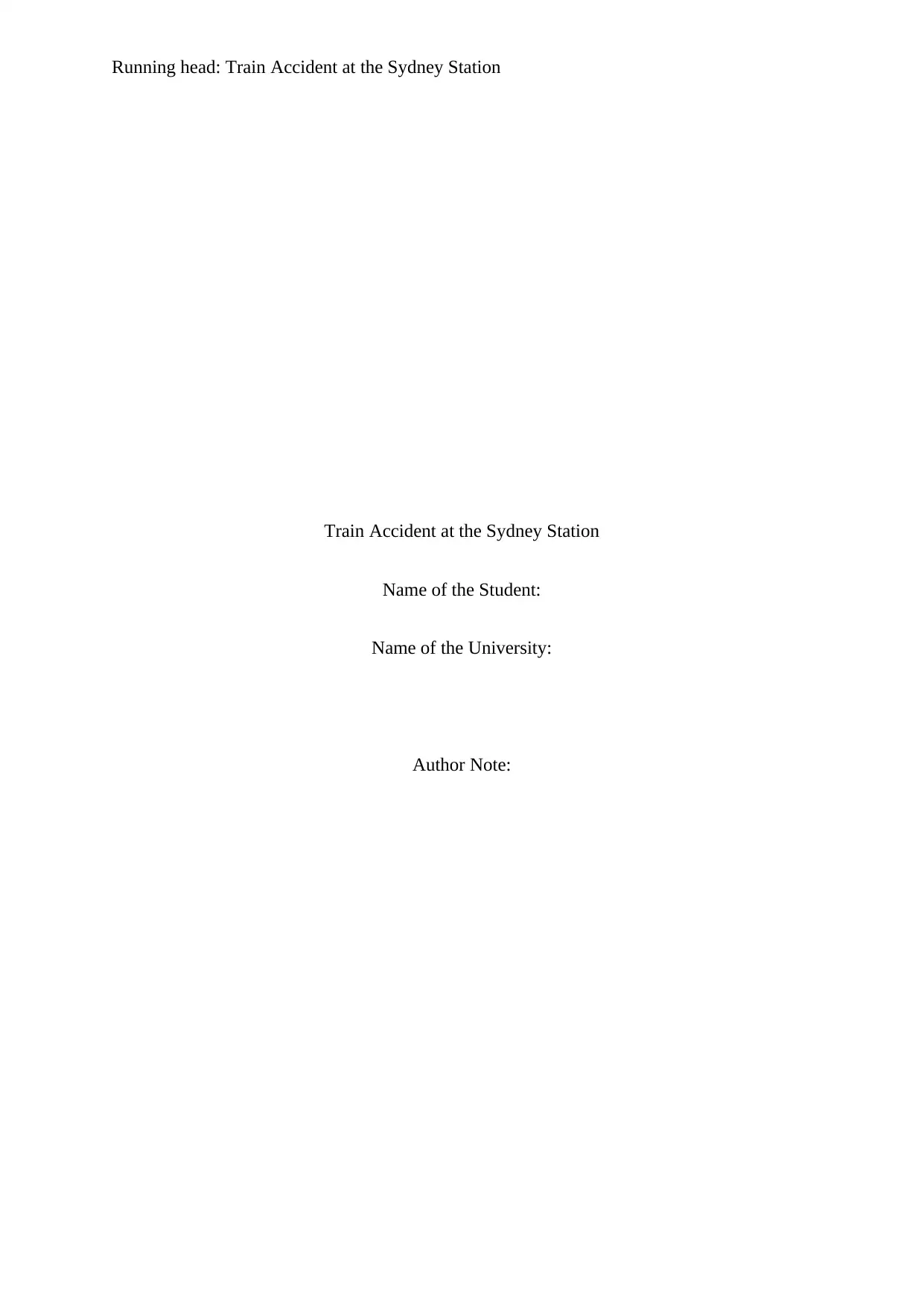
Running head: Train Accident at the Sydney Station
Train Accident at the Sydney Station
Name of the Student:
Name of the University:
Author Note:
Train Accident at the Sydney Station
Name of the Student:
Name of the University:
Author Note:
Paraphrase This Document
Need a fresh take? Get an instant paraphrase of this document with our AI Paraphraser
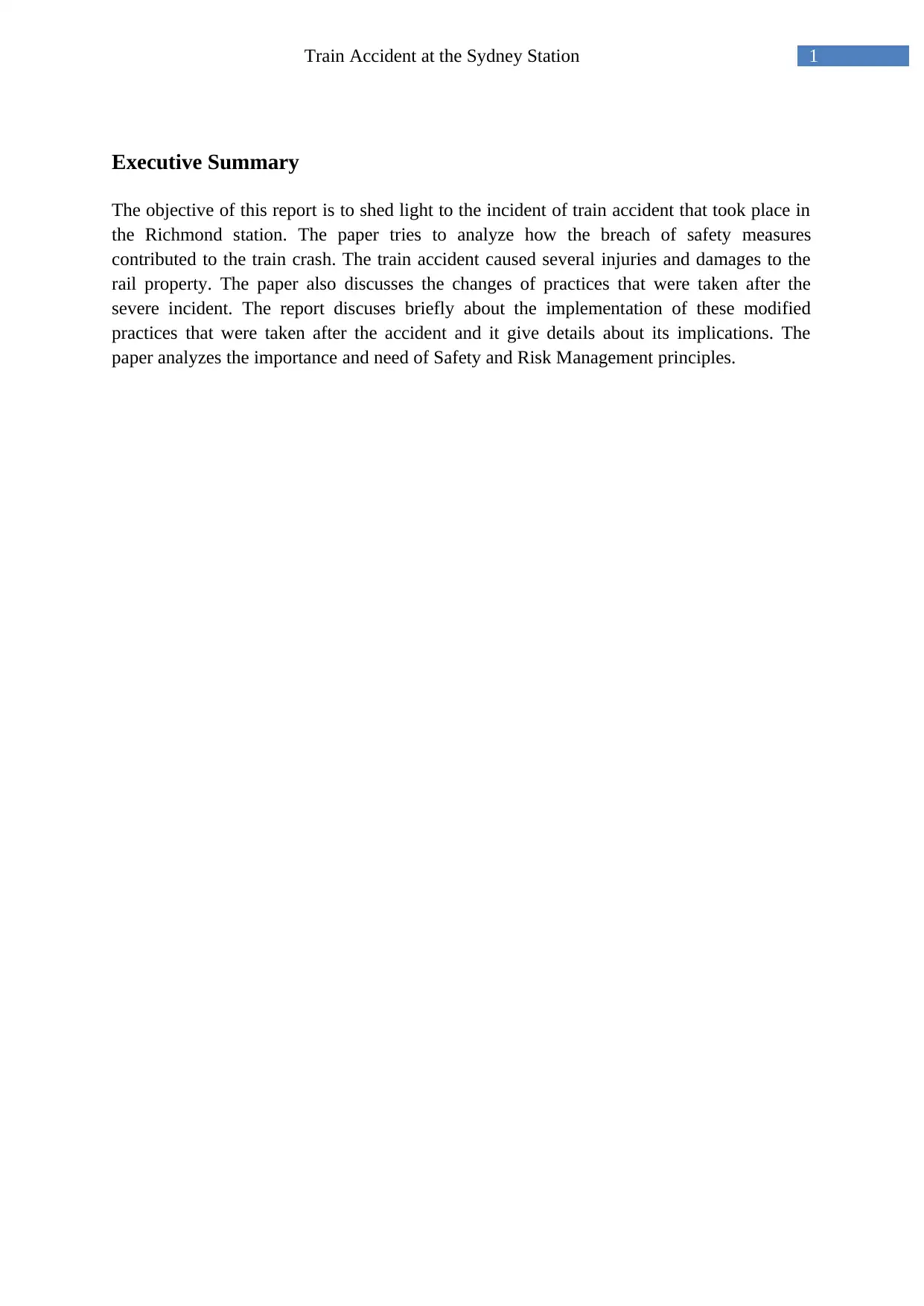
1Train Accident at the Sydney Station
Executive Summary
The objective of this report is to shed light to the incident of train accident that took place in
the Richmond station. The paper tries to analyze how the breach of safety measures
contributed to the train crash. The train accident caused several injuries and damages to the
rail property. The paper also discusses the changes of practices that were taken after the
severe incident. The report discuses briefly about the implementation of these modified
practices that were taken after the accident and it give details about its implications. The
paper analyzes the importance and need of Safety and Risk Management principles.
Executive Summary
The objective of this report is to shed light to the incident of train accident that took place in
the Richmond station. The paper tries to analyze how the breach of safety measures
contributed to the train crash. The train accident caused several injuries and damages to the
rail property. The paper also discusses the changes of practices that were taken after the
severe incident. The report discuses briefly about the implementation of these modified
practices that were taken after the accident and it give details about its implications. The
paper analyzes the importance and need of Safety and Risk Management principles.
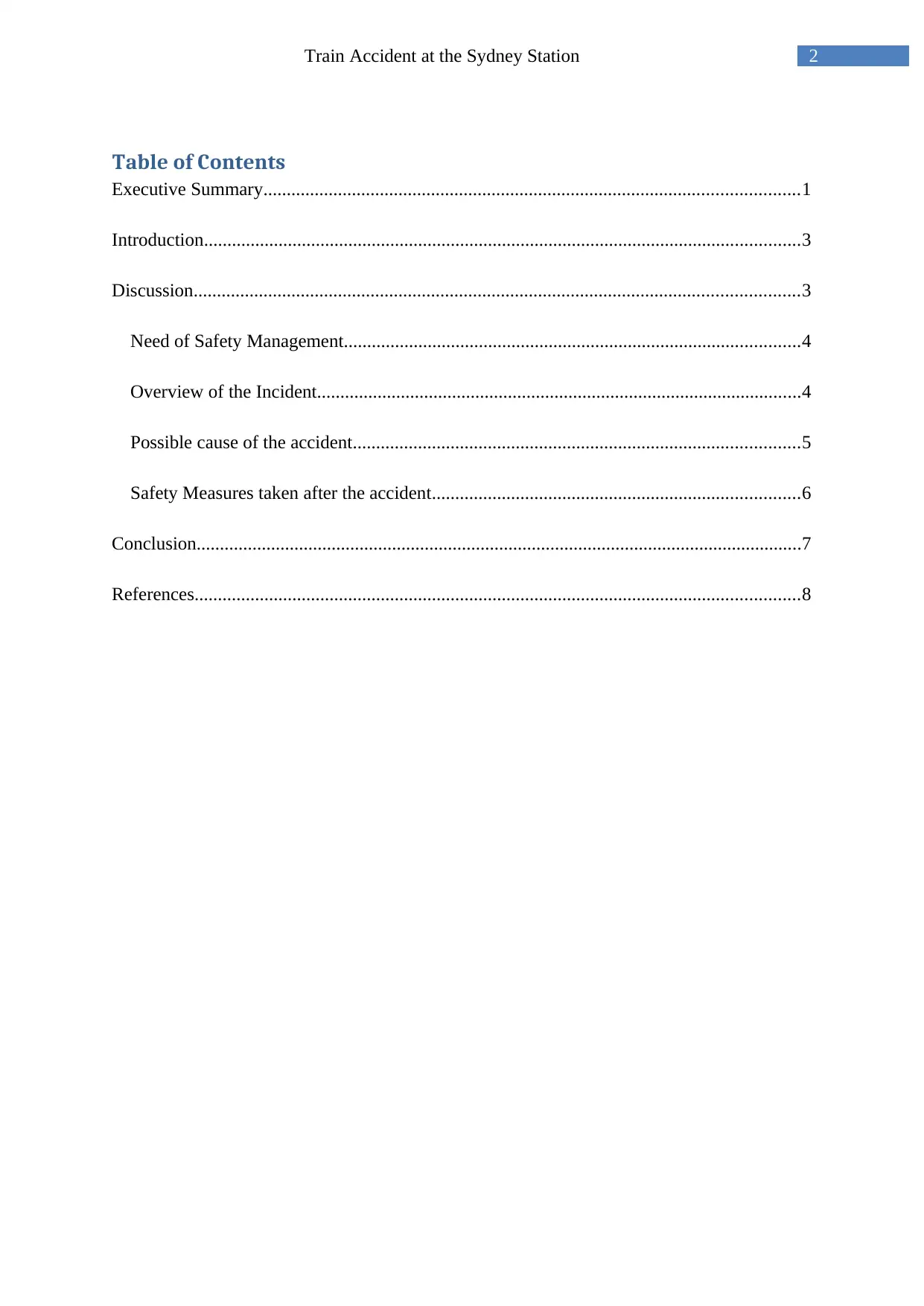
2Train Accident at the Sydney Station
Table of Contents
Executive Summary...................................................................................................................1
Introduction................................................................................................................................3
Discussion..................................................................................................................................3
Need of Safety Management..................................................................................................4
Overview of the Incident........................................................................................................4
Possible cause of the accident................................................................................................5
Safety Measures taken after the accident...............................................................................6
Conclusion..................................................................................................................................7
References..................................................................................................................................8
Table of Contents
Executive Summary...................................................................................................................1
Introduction................................................................................................................................3
Discussion..................................................................................................................................3
Need of Safety Management..................................................................................................4
Overview of the Incident........................................................................................................4
Possible cause of the accident................................................................................................5
Safety Measures taken after the accident...............................................................................6
Conclusion..................................................................................................................................7
References..................................................................................................................................8
⊘ This is a preview!⊘
Do you want full access?
Subscribe today to unlock all pages.

Trusted by 1+ million students worldwide
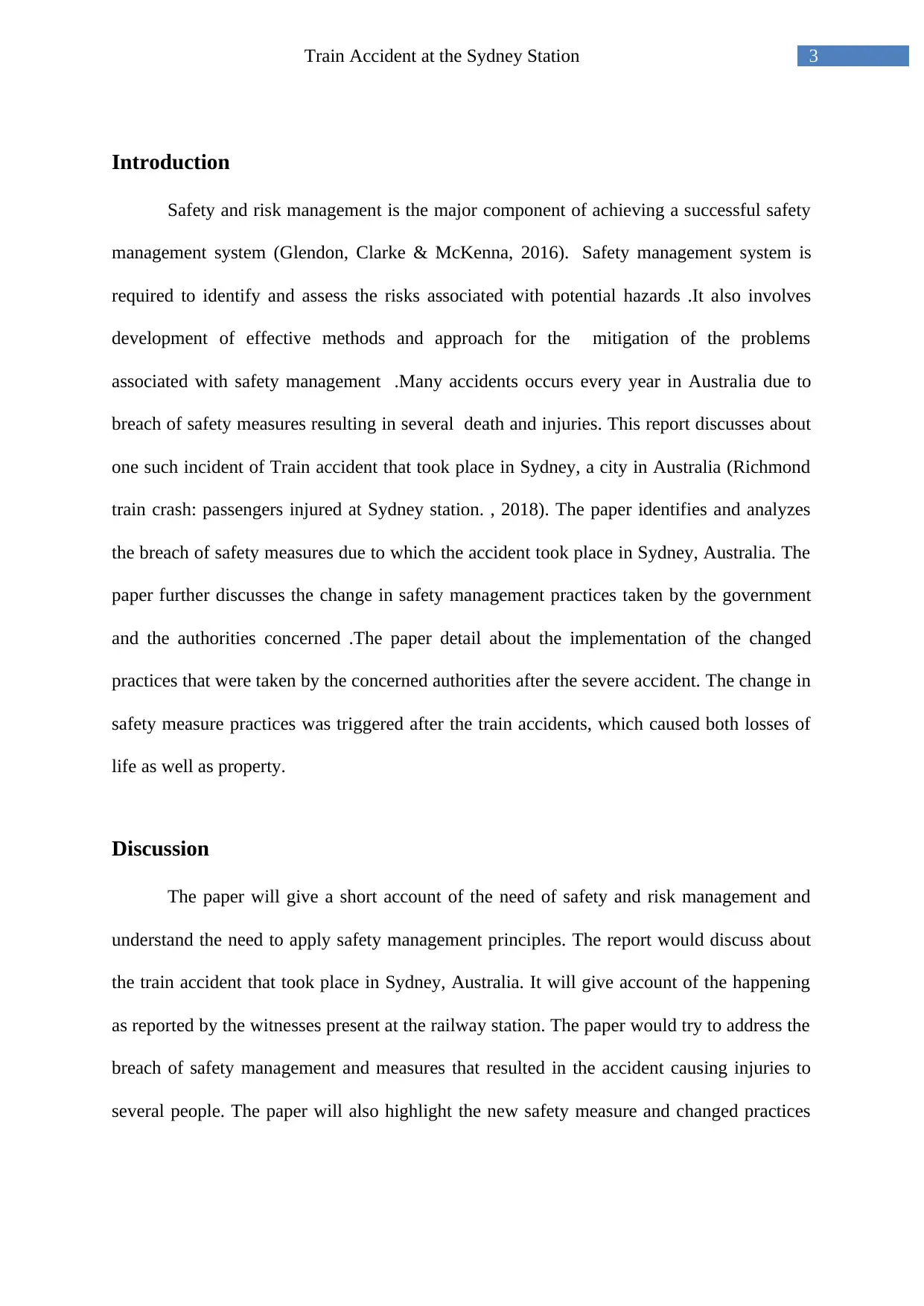
3Train Accident at the Sydney Station
Introduction
Safety and risk management is the major component of achieving a successful safety
management system (Glendon, Clarke & McKenna, 2016). Safety management system is
required to identify and assess the risks associated with potential hazards .It also involves
development of effective methods and approach for the mitigation of the problems
associated with safety management .Many accidents occurs every year in Australia due to
breach of safety measures resulting in several death and injuries. This report discusses about
one such incident of Train accident that took place in Sydney, a city in Australia (Richmond
train crash: passengers injured at Sydney station. , 2018). The paper identifies and analyzes
the breach of safety measures due to which the accident took place in Sydney, Australia. The
paper further discusses the change in safety management practices taken by the government
and the authorities concerned .The paper detail about the implementation of the changed
practices that were taken by the concerned authorities after the severe accident. The change in
safety measure practices was triggered after the train accidents, which caused both losses of
life as well as property.
Discussion
The paper will give a short account of the need of safety and risk management and
understand the need to apply safety management principles. The report would discuss about
the train accident that took place in Sydney, Australia. It will give account of the happening
as reported by the witnesses present at the railway station. The paper would try to address the
breach of safety management and measures that resulted in the accident causing injuries to
several people. The paper will also highlight the new safety measure and changed practices
Introduction
Safety and risk management is the major component of achieving a successful safety
management system (Glendon, Clarke & McKenna, 2016). Safety management system is
required to identify and assess the risks associated with potential hazards .It also involves
development of effective methods and approach for the mitigation of the problems
associated with safety management .Many accidents occurs every year in Australia due to
breach of safety measures resulting in several death and injuries. This report discusses about
one such incident of Train accident that took place in Sydney, a city in Australia (Richmond
train crash: passengers injured at Sydney station. , 2018). The paper identifies and analyzes
the breach of safety measures due to which the accident took place in Sydney, Australia. The
paper further discusses the change in safety management practices taken by the government
and the authorities concerned .The paper detail about the implementation of the changed
practices that were taken by the concerned authorities after the severe accident. The change in
safety measure practices was triggered after the train accidents, which caused both losses of
life as well as property.
Discussion
The paper will give a short account of the need of safety and risk management and
understand the need to apply safety management principles. The report would discuss about
the train accident that took place in Sydney, Australia. It will give account of the happening
as reported by the witnesses present at the railway station. The paper would try to address the
breach of safety management and measures that resulted in the accident causing injuries to
several people. The paper will also highlight the new safety measure and changed practices
Paraphrase This Document
Need a fresh take? Get an instant paraphrase of this document with our AI Paraphraser
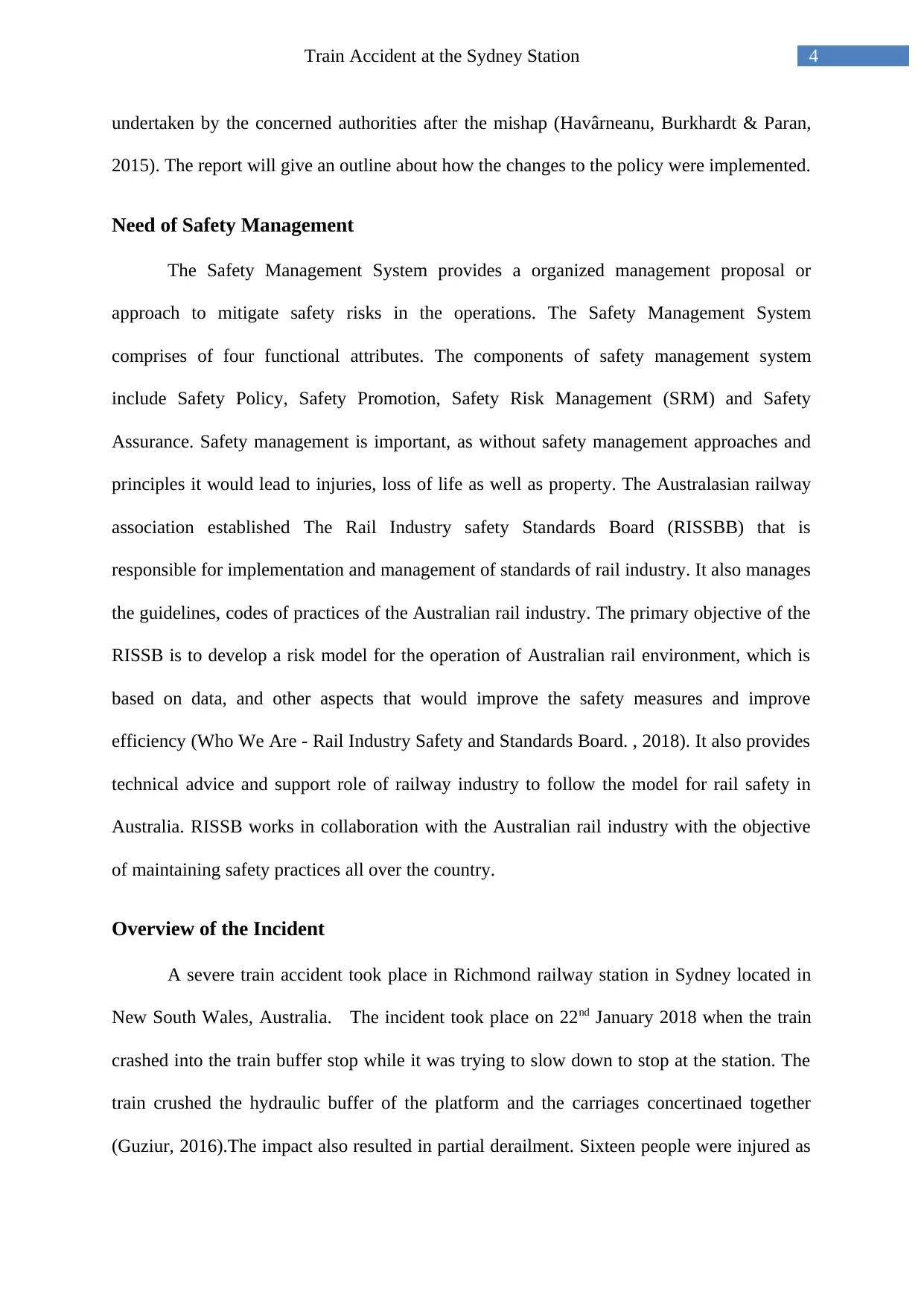
4Train Accident at the Sydney Station
undertaken by the concerned authorities after the mishap (Havârneanu, Burkhardt & Paran,
2015). The report will give an outline about how the changes to the policy were implemented.
Need of Safety Management
The Safety Management System provides a organized management proposal or
approach to mitigate safety risks in the operations. The Safety Management System
comprises of four functional attributes. The components of safety management system
include Safety Policy, Safety Promotion, Safety Risk Management (SRM) and Safety
Assurance. Safety management is important, as without safety management approaches and
principles it would lead to injuries, loss of life as well as property. The Australasian railway
association established The Rail Industry safety Standards Board (RISSBB) that is
responsible for implementation and management of standards of rail industry. It also manages
the guidelines, codes of practices of the Australian rail industry. The primary objective of the
RISSB is to develop a risk model for the operation of Australian rail environment, which is
based on data, and other aspects that would improve the safety measures and improve
efficiency (Who We Are - Rail Industry Safety and Standards Board. , 2018). It also provides
technical advice and support role of railway industry to follow the model for rail safety in
Australia. RISSB works in collaboration with the Australian rail industry with the objective
of maintaining safety practices all over the country.
Overview of the Incident
A severe train accident took place in Richmond railway station in Sydney located in
New South Wales, Australia. The incident took place on 22nd January 2018 when the train
crashed into the train buffer stop while it was trying to slow down to stop at the station. The
train crushed the hydraulic buffer of the platform and the carriages concertinaed together
(Guziur, 2016).The impact also resulted in partial derailment. Sixteen people were injured as
undertaken by the concerned authorities after the mishap (Havârneanu, Burkhardt & Paran,
2015). The report will give an outline about how the changes to the policy were implemented.
Need of Safety Management
The Safety Management System provides a organized management proposal or
approach to mitigate safety risks in the operations. The Safety Management System
comprises of four functional attributes. The components of safety management system
include Safety Policy, Safety Promotion, Safety Risk Management (SRM) and Safety
Assurance. Safety management is important, as without safety management approaches and
principles it would lead to injuries, loss of life as well as property. The Australasian railway
association established The Rail Industry safety Standards Board (RISSBB) that is
responsible for implementation and management of standards of rail industry. It also manages
the guidelines, codes of practices of the Australian rail industry. The primary objective of the
RISSB is to develop a risk model for the operation of Australian rail environment, which is
based on data, and other aspects that would improve the safety measures and improve
efficiency (Who We Are - Rail Industry Safety and Standards Board. , 2018). It also provides
technical advice and support role of railway industry to follow the model for rail safety in
Australia. RISSB works in collaboration with the Australian rail industry with the objective
of maintaining safety practices all over the country.
Overview of the Incident
A severe train accident took place in Richmond railway station in Sydney located in
New South Wales, Australia. The incident took place on 22nd January 2018 when the train
crashed into the train buffer stop while it was trying to slow down to stop at the station. The
train crushed the hydraulic buffer of the platform and the carriages concertinaed together
(Guziur, 2016).The impact also resulted in partial derailment. Sixteen people were injured as

5Train Accident at the Sydney Station
the result of the accident. The witnesses reported that the passengers were flying through the
air as the carriages of the train were splattered with blood of the injured passengers. The list
of injured people included two train employees. The injured people were immediately taken
to the nearby hospital. The injuries included fractures and bleeding. However, no fatal
injuries were reported officially. The rescue work was done in full swing with three rescue
helicopters and seventeen ambulance crews attending the injured people in the site of the
mishap. There were bloods everywhere near the site of accident making it a complete blood
bath. The casualties also included two aged people. The driver of the train suffered minor
injuries whereas the train guards suffered facial and chest injuries. Paramedical team went to
the site of accident and treated the injured people .Out of the injured people two had serious
injuries so they were taken to the nearby Westmead hospital. Some reports also stated that
three people were trapped inside the train who were rescued by the rescue team.
Possible cause of the accident
The Office of Transport Safety of Australia, Australian Transport Safety Bureau and
Office of National Rail Safety Regulator investigated the accident that took place in
Richmond station in Sydney. The driver Mr. Mittal has been removed from the duties of the
driver after this accident. The initial report from the Australian Transport Safety Bureau
revealed that the driver involved in the accident, Mr. Mittal was found to be fully qualified,
aware of the route, experienced and he was passed as medically fit. It was also reported that
there were no signs of contaminants in the rails (Saat et al 2014). According to the report, it
was suggested that speed was not the issue during the occurrence of the incident. However,
the report failed to shed any light on the possible cause of the accident. Australia Transport
Safety Bureau would continue further investigations about the maintenance history of train,
warning systems as well as brakes of the train, performance of the crew and the conditions of
the track (Oswald & Sutherland, 2016). From the early reports, it has been proved that there
the result of the accident. The witnesses reported that the passengers were flying through the
air as the carriages of the train were splattered with blood of the injured passengers. The list
of injured people included two train employees. The injured people were immediately taken
to the nearby hospital. The injuries included fractures and bleeding. However, no fatal
injuries were reported officially. The rescue work was done in full swing with three rescue
helicopters and seventeen ambulance crews attending the injured people in the site of the
mishap. There were bloods everywhere near the site of accident making it a complete blood
bath. The casualties also included two aged people. The driver of the train suffered minor
injuries whereas the train guards suffered facial and chest injuries. Paramedical team went to
the site of accident and treated the injured people .Out of the injured people two had serious
injuries so they were taken to the nearby Westmead hospital. Some reports also stated that
three people were trapped inside the train who were rescued by the rescue team.
Possible cause of the accident
The Office of Transport Safety of Australia, Australian Transport Safety Bureau and
Office of National Rail Safety Regulator investigated the accident that took place in
Richmond station in Sydney. The driver Mr. Mittal has been removed from the duties of the
driver after this accident. The initial report from the Australian Transport Safety Bureau
revealed that the driver involved in the accident, Mr. Mittal was found to be fully qualified,
aware of the route, experienced and he was passed as medically fit. It was also reported that
there were no signs of contaminants in the rails (Saat et al 2014). According to the report, it
was suggested that speed was not the issue during the occurrence of the incident. However,
the report failed to shed any light on the possible cause of the accident. Australia Transport
Safety Bureau would continue further investigations about the maintenance history of train,
warning systems as well as brakes of the train, performance of the crew and the conditions of
the track (Oswald & Sutherland, 2016). From the early reports, it has been proved that there
⊘ This is a preview!⊘
Do you want full access?
Subscribe today to unlock all pages.

Trusted by 1+ million students worldwide
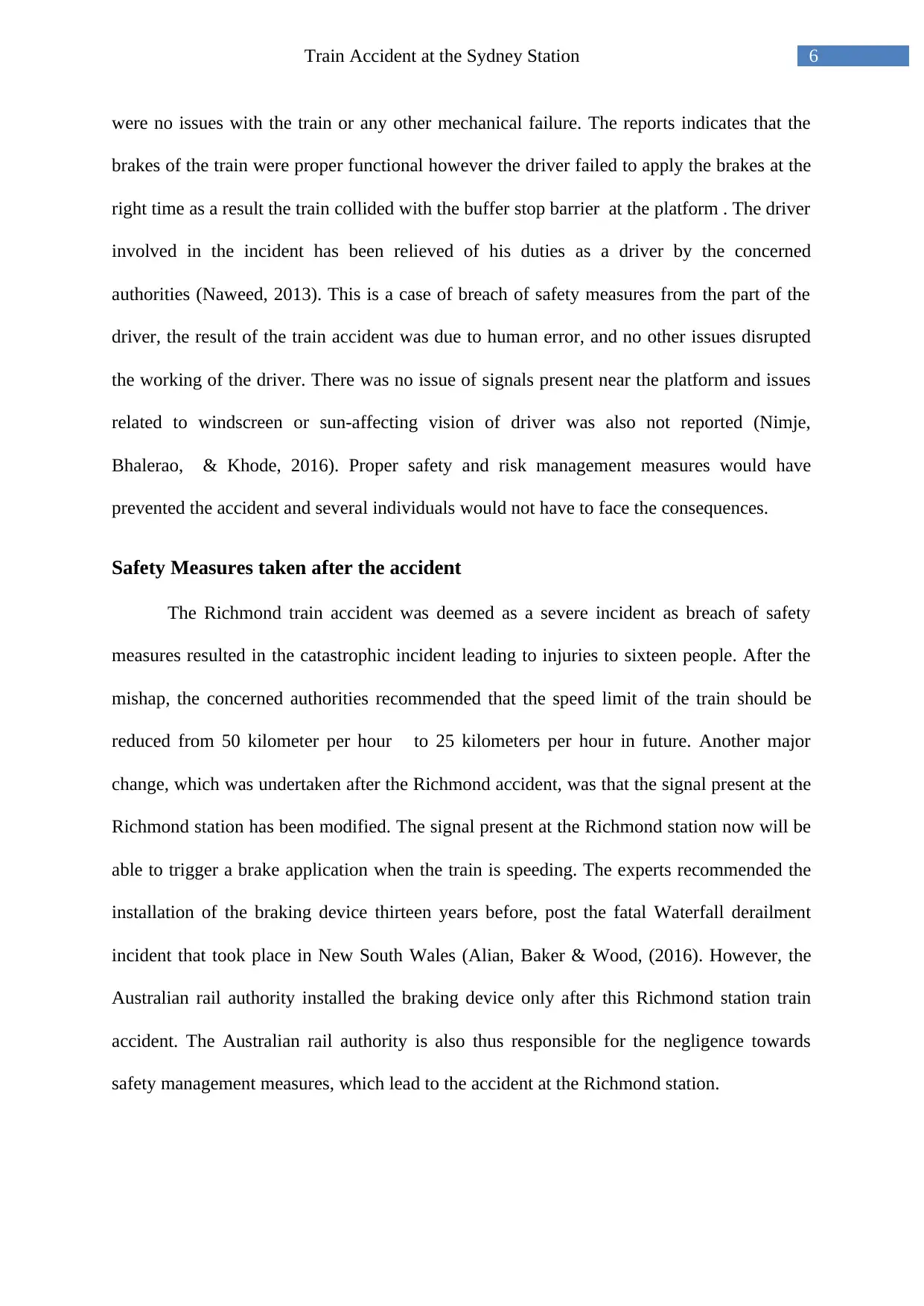
6Train Accident at the Sydney Station
were no issues with the train or any other mechanical failure. The reports indicates that the
brakes of the train were proper functional however the driver failed to apply the brakes at the
right time as a result the train collided with the buffer stop barrier at the platform . The driver
involved in the incident has been relieved of his duties as a driver by the concerned
authorities (Naweed, 2013). This is a case of breach of safety measures from the part of the
driver, the result of the train accident was due to human error, and no other issues disrupted
the working of the driver. There was no issue of signals present near the platform and issues
related to windscreen or sun-affecting vision of driver was also not reported (Nimje,
Bhalerao, & Khode, 2016). Proper safety and risk management measures would have
prevented the accident and several individuals would not have to face the consequences.
Safety Measures taken after the accident
The Richmond train accident was deemed as a severe incident as breach of safety
measures resulted in the catastrophic incident leading to injuries to sixteen people. After the
mishap, the concerned authorities recommended that the speed limit of the train should be
reduced from 50 kilometer per hour to 25 kilometers per hour in future. Another major
change, which was undertaken after the Richmond accident, was that the signal present at the
Richmond station has been modified. The signal present at the Richmond station now will be
able to trigger a brake application when the train is speeding. The experts recommended the
installation of the braking device thirteen years before, post the fatal Waterfall derailment
incident that took place in New South Wales (Alian, Baker & Wood, (2016). However, the
Australian rail authority installed the braking device only after this Richmond station train
accident. The Australian rail authority is also thus responsible for the negligence towards
safety management measures, which lead to the accident at the Richmond station.
were no issues with the train or any other mechanical failure. The reports indicates that the
brakes of the train were proper functional however the driver failed to apply the brakes at the
right time as a result the train collided with the buffer stop barrier at the platform . The driver
involved in the incident has been relieved of his duties as a driver by the concerned
authorities (Naweed, 2013). This is a case of breach of safety measures from the part of the
driver, the result of the train accident was due to human error, and no other issues disrupted
the working of the driver. There was no issue of signals present near the platform and issues
related to windscreen or sun-affecting vision of driver was also not reported (Nimje,
Bhalerao, & Khode, 2016). Proper safety and risk management measures would have
prevented the accident and several individuals would not have to face the consequences.
Safety Measures taken after the accident
The Richmond train accident was deemed as a severe incident as breach of safety
measures resulted in the catastrophic incident leading to injuries to sixteen people. After the
mishap, the concerned authorities recommended that the speed limit of the train should be
reduced from 50 kilometer per hour to 25 kilometers per hour in future. Another major
change, which was undertaken after the Richmond accident, was that the signal present at the
Richmond station has been modified. The signal present at the Richmond station now will be
able to trigger a brake application when the train is speeding. The experts recommended the
installation of the braking device thirteen years before, post the fatal Waterfall derailment
incident that took place in New South Wales (Alian, Baker & Wood, (2016). However, the
Australian rail authority installed the braking device only after this Richmond station train
accident. The Australian rail authority is also thus responsible for the negligence towards
safety management measures, which lead to the accident at the Richmond station.
Paraphrase This Document
Need a fresh take? Get an instant paraphrase of this document with our AI Paraphraser
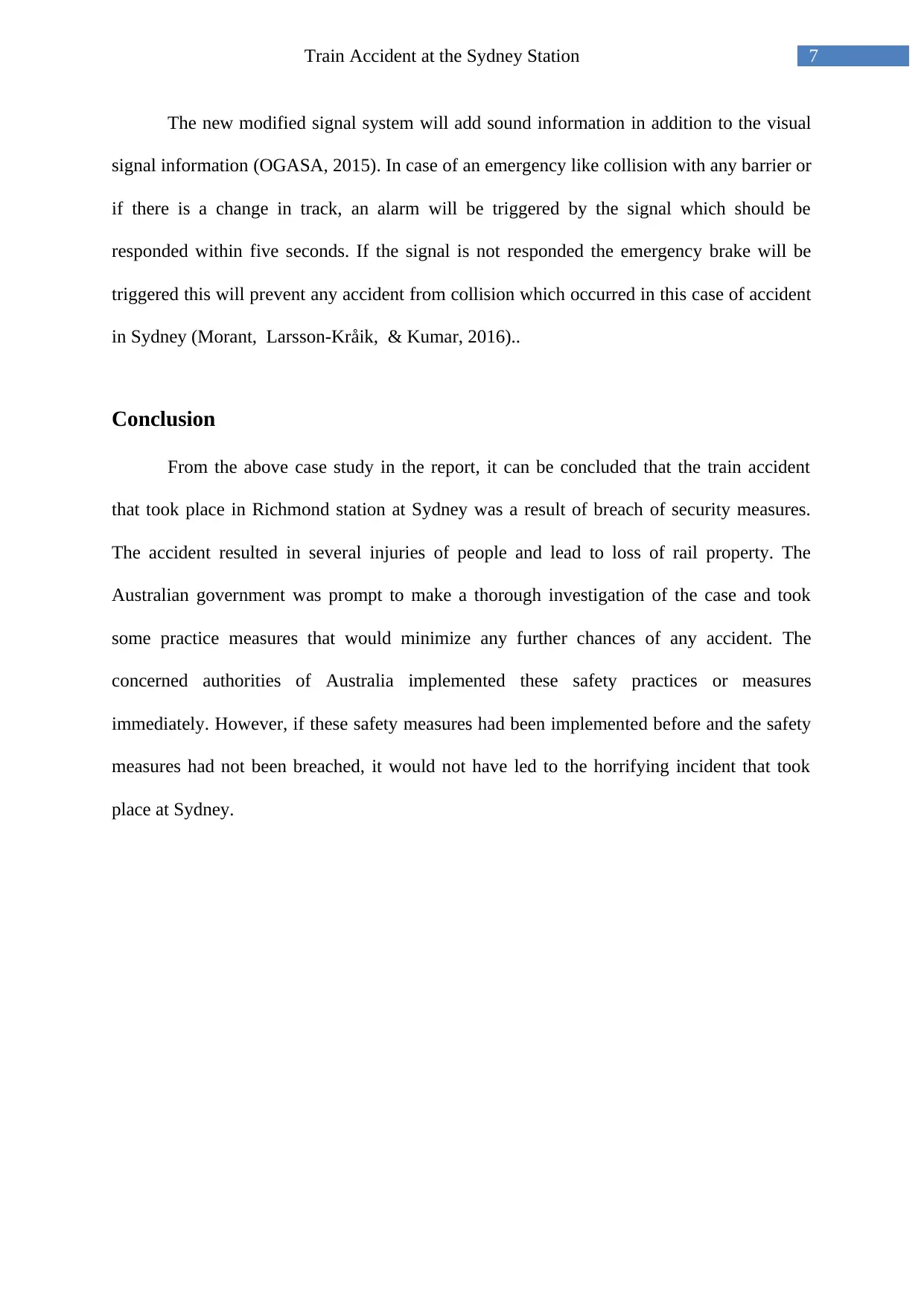
7Train Accident at the Sydney Station
The new modified signal system will add sound information in addition to the visual
signal information (OGASA, 2015). In case of an emergency like collision with any barrier or
if there is a change in track, an alarm will be triggered by the signal which should be
responded within five seconds. If the signal is not responded the emergency brake will be
triggered this will prevent any accident from collision which occurred in this case of accident
in Sydney (Morant, Larsson-Kråik, & Kumar, 2016)..
Conclusion
From the above case study in the report, it can be concluded that the train accident
that took place in Richmond station at Sydney was a result of breach of security measures.
The accident resulted in several injuries of people and lead to loss of rail property. The
Australian government was prompt to make a thorough investigation of the case and took
some practice measures that would minimize any further chances of any accident. The
concerned authorities of Australia implemented these safety practices or measures
immediately. However, if these safety measures had been implemented before and the safety
measures had not been breached, it would not have led to the horrifying incident that took
place at Sydney.
The new modified signal system will add sound information in addition to the visual
signal information (OGASA, 2015). In case of an emergency like collision with any barrier or
if there is a change in track, an alarm will be triggered by the signal which should be
responded within five seconds. If the signal is not responded the emergency brake will be
triggered this will prevent any accident from collision which occurred in this case of accident
in Sydney (Morant, Larsson-Kråik, & Kumar, 2016)..
Conclusion
From the above case study in the report, it can be concluded that the train accident
that took place in Richmond station at Sydney was a result of breach of security measures.
The accident resulted in several injuries of people and lead to loss of rail property. The
Australian government was prompt to make a thorough investigation of the case and took
some practice measures that would minimize any further chances of any accident. The
concerned authorities of Australia implemented these safety practices or measures
immediately. However, if these safety measures had been implemented before and the safety
measures had not been breached, it would not have led to the horrifying incident that took
place at Sydney.
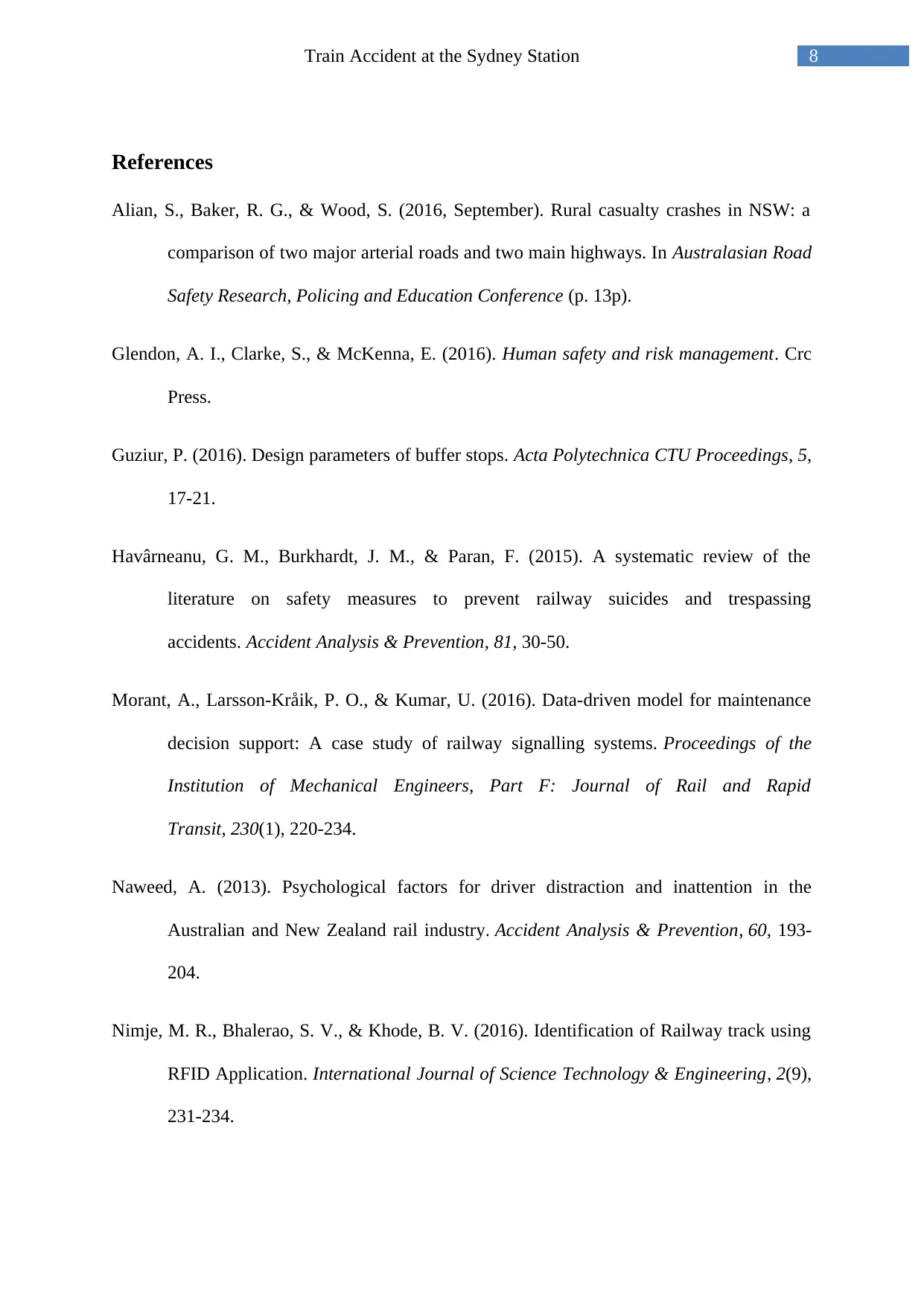
8Train Accident at the Sydney Station
References
Alian, S., Baker, R. G., & Wood, S. (2016, September). Rural casualty crashes in NSW: a
comparison of two major arterial roads and two main highways. In Australasian Road
Safety Research, Policing and Education Conference (p. 13p).
Glendon, A. I., Clarke, S., & McKenna, E. (2016). Human safety and risk management. Crc
Press.
Guziur, P. (2016). Design parameters of buffer stops. Acta Polytechnica CTU Proceedings, 5,
17-21.
Havârneanu, G. M., Burkhardt, J. M., & Paran, F. (2015). A systematic review of the
literature on safety measures to prevent railway suicides and trespassing
accidents. Accident Analysis & Prevention, 81, 30-50.
Morant, A., Larsson-Kråik, P. O., & Kumar, U. (2016). Data-driven model for maintenance
decision support: A case study of railway signalling systems. Proceedings of the
Institution of Mechanical Engineers, Part F: Journal of Rail and Rapid
Transit, 230(1), 220-234.
Naweed, A. (2013). Psychological factors for driver distraction and inattention in the
Australian and New Zealand rail industry. Accident Analysis & Prevention, 60, 193-
204.
Nimje, M. R., Bhalerao, S. V., & Khode, B. V. (2016). Identification of Railway track using
RFID Application. International Journal of Science Technology & Engineering, 2(9),
231-234.
References
Alian, S., Baker, R. G., & Wood, S. (2016, September). Rural casualty crashes in NSW: a
comparison of two major arterial roads and two main highways. In Australasian Road
Safety Research, Policing and Education Conference (p. 13p).
Glendon, A. I., Clarke, S., & McKenna, E. (2016). Human safety and risk management. Crc
Press.
Guziur, P. (2016). Design parameters of buffer stops. Acta Polytechnica CTU Proceedings, 5,
17-21.
Havârneanu, G. M., Burkhardt, J. M., & Paran, F. (2015). A systematic review of the
literature on safety measures to prevent railway suicides and trespassing
accidents. Accident Analysis & Prevention, 81, 30-50.
Morant, A., Larsson-Kråik, P. O., & Kumar, U. (2016). Data-driven model for maintenance
decision support: A case study of railway signalling systems. Proceedings of the
Institution of Mechanical Engineers, Part F: Journal of Rail and Rapid
Transit, 230(1), 220-234.
Naweed, A. (2013). Psychological factors for driver distraction and inattention in the
Australian and New Zealand rail industry. Accident Analysis & Prevention, 60, 193-
204.
Nimje, M. R., Bhalerao, S. V., & Khode, B. V. (2016). Identification of Railway track using
RFID Application. International Journal of Science Technology & Engineering, 2(9),
231-234.
⊘ This is a preview!⊘
Do you want full access?
Subscribe today to unlock all pages.

Trusted by 1+ million students worldwide
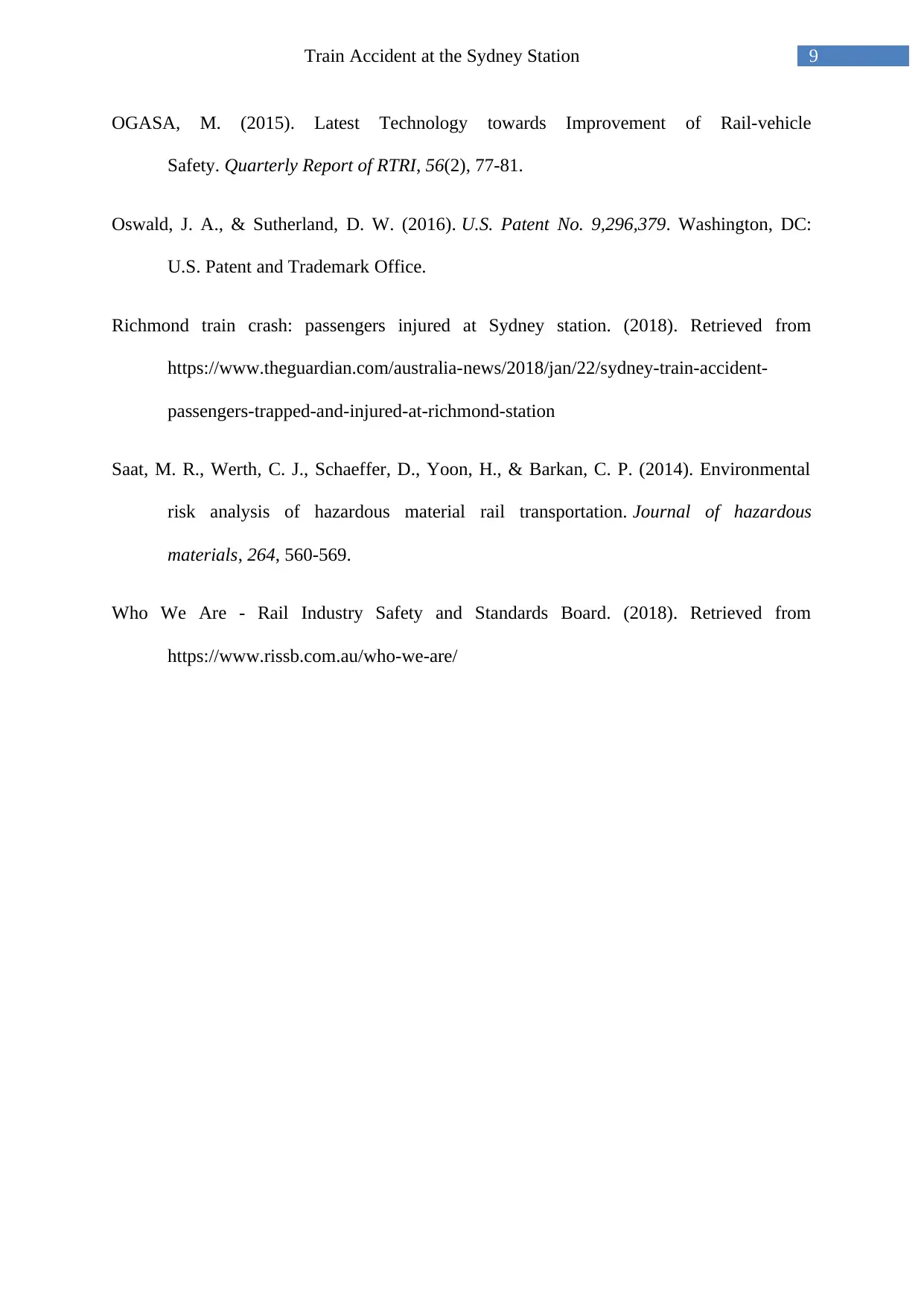
9Train Accident at the Sydney Station
OGASA, M. (2015). Latest Technology towards Improvement of Rail-vehicle
Safety. Quarterly Report of RTRI, 56(2), 77-81.
Oswald, J. A., & Sutherland, D. W. (2016). U.S. Patent No. 9,296,379. Washington, DC:
U.S. Patent and Trademark Office.
Richmond train crash: passengers injured at Sydney station. (2018). Retrieved from
https://www.theguardian.com/australia-news/2018/jan/22/sydney-train-accident-
passengers-trapped-and-injured-at-richmond-station
Saat, M. R., Werth, C. J., Schaeffer, D., Yoon, H., & Barkan, C. P. (2014). Environmental
risk analysis of hazardous material rail transportation. Journal of hazardous
materials, 264, 560-569.
Who We Are - Rail Industry Safety and Standards Board. (2018). Retrieved from
https://www.rissb.com.au/who-we-are/
OGASA, M. (2015). Latest Technology towards Improvement of Rail-vehicle
Safety. Quarterly Report of RTRI, 56(2), 77-81.
Oswald, J. A., & Sutherland, D. W. (2016). U.S. Patent No. 9,296,379. Washington, DC:
U.S. Patent and Trademark Office.
Richmond train crash: passengers injured at Sydney station. (2018). Retrieved from
https://www.theguardian.com/australia-news/2018/jan/22/sydney-train-accident-
passengers-trapped-and-injured-at-richmond-station
Saat, M. R., Werth, C. J., Schaeffer, D., Yoon, H., & Barkan, C. P. (2014). Environmental
risk analysis of hazardous material rail transportation. Journal of hazardous
materials, 264, 560-569.
Who We Are - Rail Industry Safety and Standards Board. (2018). Retrieved from
https://www.rissb.com.au/who-we-are/
1 out of 10
Related Documents
Your All-in-One AI-Powered Toolkit for Academic Success.
+13062052269
info@desklib.com
Available 24*7 on WhatsApp / Email
![[object Object]](/_next/static/media/star-bottom.7253800d.svg)
Unlock your academic potential
Copyright © 2020–2025 A2Z Services. All Rights Reserved. Developed and managed by ZUCOL.





